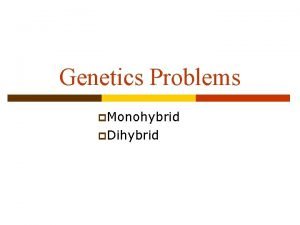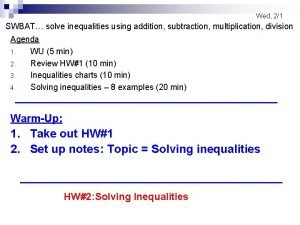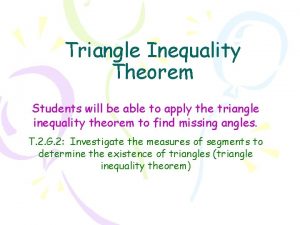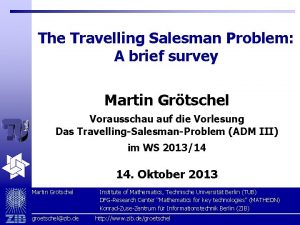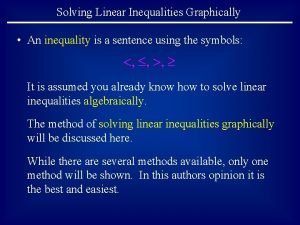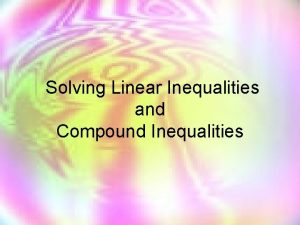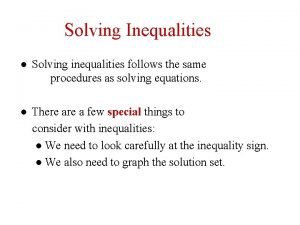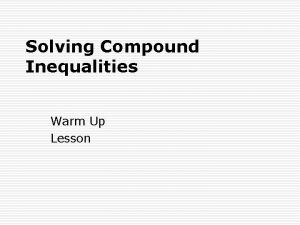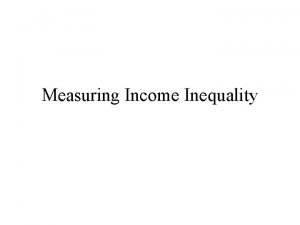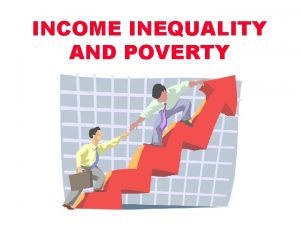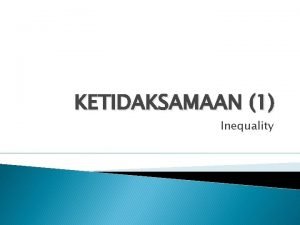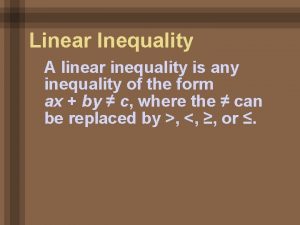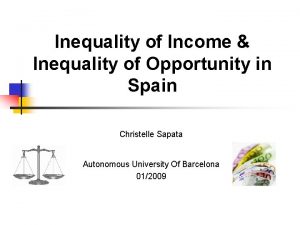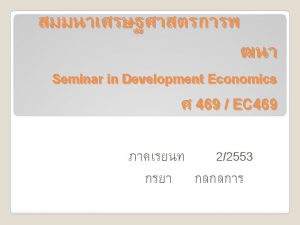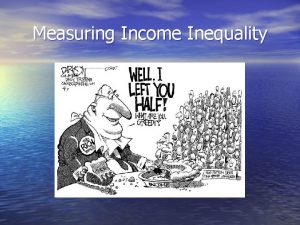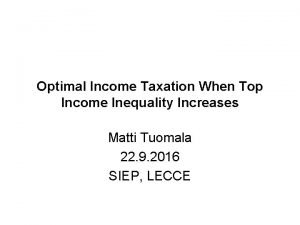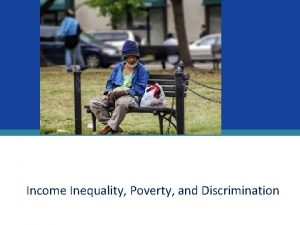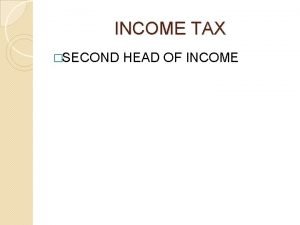A short review of income inequality in China






























- Slides: 30

A short review of income inequality in China Branko Milanovic Graduate Center, CUNY, Spring 2014 Have a look at my vignette “Will China survive in 2048? ” in The haves and the have-nots Branko Milanovic

Data on income inequality in China • Almost nothing before 1980 -82 when the first “new” surveys are conducted • Surveys existed before the Cultural Revolution but they are lost • There are some fragmentary, provincial data going back to the 1930 s and 1920 s • Surveys done separately for urban & rural areas but from 2013 a single unified survey • The issue of “floating population”, not well included in surveys • Also, China CASS surveys 1998 -2011 (5 surveys) • Kanbur & Zhang use mean R/U provincial incomes as inequality proxy Branko Milanovic

Standard political periodization 1949 -56 Revolution & land reform 1957 -61 “Great Leap Forward” 1962 -65 Post-famine recovery 1966 -78 Cultural Revolution 1979 -85 Rural reforms Post 1985. Urban reform, decentralization, trade openness • Post 2000. De facto capitalism, Jiang Zemin “The 3 represents” • • • Branko Milanovic

Basic policy outline since the reforms • 1978. “Responsibility system” in rural areas and 14 special economic zones (Shenzhen the most famous) • Large increases in rural incomes, declines in absolute poverty & moderate increase in Gini • 1990 s. Urban reforms. Urban incomes take off, U/R gap increases, poverty reduction more moderate (but also due to China becoming richer) • 2000 s. Rising U/R gap, increasing share of K income among urban population, corruption & new wealth Branko Milanovic

Inter-personal inequality Branko Milanovic

Urban and rural Ginis, 1985 -2001 45 all 40 35 Gini coefficient 30 25 rural areas urban areas 20 15 10 5 19 86 19 87 19 88 19 89 19 90 19 91 19 92 19 93 19 94 19 95 19 96 19 97 19 98 19 99 20 00 20 01 0 • Based on official published fractiles for rural and urban household surveys • All 30 provinces included • 30 -40, 000 HHs in urban, 60 -70, 000 in rural areas • From Xu and Perloff (2004) • Unusual to have greater Gini in rural areas From wu_perloff_weichu. xls Branko Milanovic

Urban and rural Ginis from official surveys 1987 -2010 (based on World Bank POVCAL) 45 Rural Gini coefficient 40 35 Urban 30 25 20 1987 1990 From ruralurban_Ginii_88_10. xls 1992 1993 1994 1995 1996 1997 Year Branko Milanovic 1998 1999 2002 2005 2008 2010

Urban Ginis 1998 -2009, alternative calculation • Gini calculated across individuals with nonzero incomes, not household per capita income • Based on micro data from HS • From Wei Chu, JCE, 2012 Gini coefficient for urban areas of China, 1988 -2009 50 45 40 35 30 25 20 15 10 5 1988 1989 1990 1991 1992 1993 1994 1995 1996 1997 1998 1999 2000 2001 2002 2003 2004 2005 2006 2007 2008 2009 0 From wu_perloff_weichu. xls Branko Milanovic

Top income shares in China and India, 1986 -2003 Figure 3 : The top 1% income share in China and India, 1986 -2003 10% 9% 8% 7% 6% Top 1% share (China) 5% Top 1% share (India) 4% 3% 2% 2003 2002 2000 2001 1999 1998 1997 1996 1995 1994 1993 1992 1991 1990 1989 1988 1987 0% 1986 1% Source: China: authoss' computations using household surveys tabulations (Data Appendix, Table A 5, col. (4), ind. distribution) ; India: auhors' computations using income tax returns data (see Banerjee and Piketty (2004, Table A 3, col. (1))) • Rising top (1%) income share in both countries • Still lower in China • India: based on fiscal data with v. different income cut-off points and compliance • From Banerjee and Piketty, 2004 • China: from HH surveys Branko Milanovic

Wealth inequality: BRICS and the US Wealth of billionaires as percentage of GDP (year 2012) 25. 0 20. 0 15. 0 10. 0 5. 0 0. 0 India From Forbes 2013. xls China & Russia Hong Kong Brazil Branko Milanovic South Africa Mexico USA

Regional, costal-inland urban-rural inequality Branko Milanovic

Infant mortality rate in 2005 (from Kanbur and Zhang) 73/1000 Urban/Rural IMR = 2. 2 Branko Milanovic Inland/Coast IMR = 2. 1

GDGDP per capita in 2008 (from Kanbur & Zhang) $10, 000 $1, 000 Urban/Rural income=3. 3 Branko Milanovic Inland/Coast income=2. 2

Richer provinces also grew faster: China (1980 -2000) North to South Shandong Jiangsu Zhejiang Fujian Guangdong Red: fast growth (1σ above the mean) Yellow: average Light yellow: slow (1σ below the mean) Branko Milanovic

Inland-coastal gap & trade openness (from Kanbur & Zhang) Planning era Reform era 80 3. 5 70 3. 0 60 2. 5 Openness 50 2. 0 Trade ratio 40 1. 5 30 1. 0 20 0. 5 10 0 1950 1960 1970 1980 1990 Branko Milanovic 2000 0. 0 2010 Inland-coastal disparity

Decentralization and regressive tax pressure further exacerbate regional inequality (from Kanbur & Zhang) 90 40. 0 80 35. 0 70 30. 0 60 25. 0 50 20. 0 Gini 40 15. 0 30 10. 0 20 5. 0 10 0 1950 Decentralization 1960 1970 1980 1990 Branko Milanovic 2000 0. 0 2010

China: Uneven fiscal burden across provinces from Zhang (2006) Branko Milanovic

Putting geographical and interpersonal inequality together Branko Milanovic

China and India compared (Gini points) China 2000 India 1997 Inequality between provinces/states Rural-urban inequality 24 22 13 7 Inequality within R/U areas Total inequality 7 9 44 38 3. 1 -1 1. 8 -1 Urban-rural ratio Branko Milanovic From India. China. xls file; China: based on HBS data; India based on state GDIs, italics: estimates

Illustration of Concepts 2 and 3: China, inequality according to HS data Branko Milanovic

Decomposing total inequality in China Based on Ravallion & Chen (2004), Kanbur & Zhang (2002), Milanovic (2004) Branko Milanovic

China has many unique features • Rising inequality in all its dimensions: between people overall, between provinces, between coast and inland regions, between urban and rural (e. g. US has only 1 of these dimensions) • U/R disparity is the most significant; highest in the world • A part of population lives in urban area but not registered there • Rural Gini as high as urban Gini • Rapid increase in inequality accompanied by rapid growth and decrease in poverty • Nominal Communist country with rising share of capitalists and K income Branko Milanovic

What is not so unique • Gap in pay and benefits between public & private enterprises • Chinese inequality might have gone up along the rising slope of the Kuznets curve (as the US did in 1870 -1928), but now ready to go down now (aging, welfare reforms) • Pro-Western regional reforms, anti-corruption drive attempt to redress some of these imbalances Branko Milanovic

China vs. USA: a short comparison Branko Milanovic

Chinese and US distribution on the same scale twoway (kdensity log 10 inc if contcod=="USA") (kdensity log 10 inc if contcod=="CHN", xlabel(2. 477 "300" 3 "1000" 4 "10000" 4. 7 "50 K" 5 "100 k") legend(off) xtitle(per capita income in PPP dollars) ytitle(density) text(0. 9 3 "China") text(0. 7 4. 8 "USA")) Branko Milanovic Using final 08. dta

Inequality in China and the United States Branko Milanovic

percentile of world income distribution 10 20 30 40 50 60 70 80 90 100 Different countries and income classes in global income distribution in 2008 USA Brazil Russia China India 1 Branko Milanovic 1 From calcu 08. dta 20 40 60 country percentile 80 100

Share of US and China in world GDP (according to World Bank data) twoway (scatter rel. GDP year if contcod=="USA", connect(l)) (scatter rel. GDP year if contcod=="CHN", connect(l) legend(off) text(0. 22 2012 "USA") text(0. 17 2012 "CHN")) using gdppppreg 4. dta Branko Milanovic

Share of private household consumption in GDI twoway (scatter consgdp year if contcod=="CHN", connect(l)) (scatter consgdp year if contcod=="IND", connect(l) legend(off) text(0. 7 1990 "India") text(0. 55 1990 "China")) Branko Milanovic

Top 1% and top 10% shares in China and the US (according to Saez, and Piketty and Qian) Top 1% Top 10% China 2003 9. 7% 27. 9% United States 2003 22. 0% 50. 0% Source: China: Piketty and Qian, in Piketty. Qian_AJEPP 2009. xla (whole_countriesChina 0 USA: Saez, strikiing it richer, 2008 in ydistrusasaez-ustopincomes-2006 prelpdf Branko Milanovic
 Tall+short h
Tall+short h 1-6 solving compound and absolute value inequalities
1-6 solving compound and absolute value inequalities Value added method gdp
Value added method gdp Ttd and dtd
Ttd and dtd Net operating income
Net operating income Calculate income tax
Calculate income tax Exterior angle inequality theorem
Exterior angle inequality theorem Short poem about gender equality
Short poem about gender equality Chapter review motion part a vocabulary review answer key
Chapter review motion part a vocabulary review answer key Writ of certiorari ap gov example
Writ of certiorari ap gov example Nader amin-salehi
Nader amin-salehi Systematic review definition
Systematic review definition Narrative review vs systematic review
Narrative review vs systematic review Short book review examples
Short book review examples Short story unit test
Short story unit test Short book review for students
Short book review for students Fiction story example
Fiction story example Hh
Hh Inequality phrases
Inequality phrases Triangle side sum theorem
Triangle side sum theorem Inequality theorem
Inequality theorem Exterior angle inequality theorem
Exterior angle inequality theorem Travelling salesman problem ppt
Travelling salesman problem ppt Packet 22 inequality word problems
Packet 22 inequality word problems How to solve inequalities graphically
How to solve inequalities graphically Linear inequality symbols
Linear inequality symbols Whats an inequality
Whats an inequality Open closed circle graph
Open closed circle graph Multiplication property of inequality
Multiplication property of inequality Write compound inequalities from graphs
Write compound inequalities from graphs Social inequality examples
Social inequality examples

















